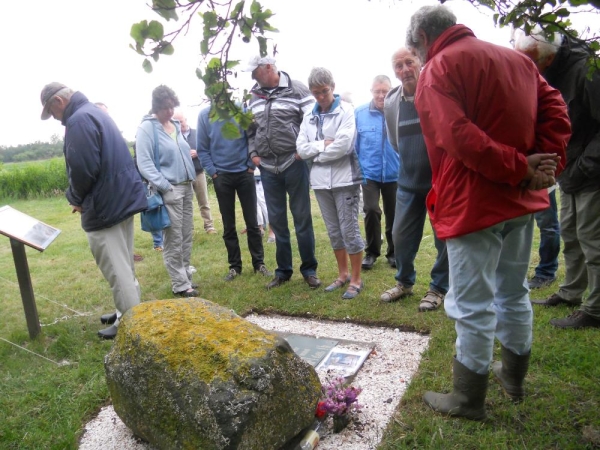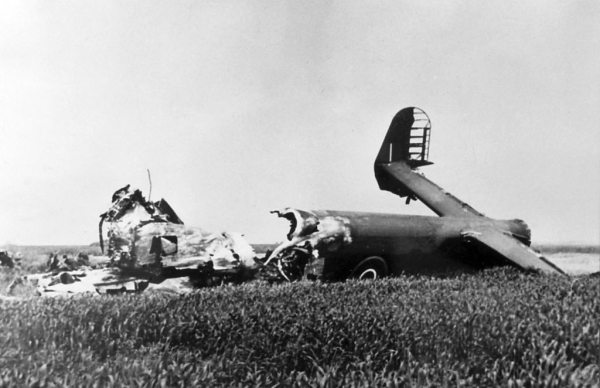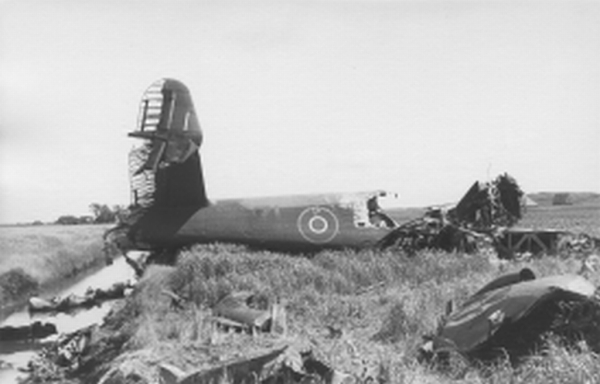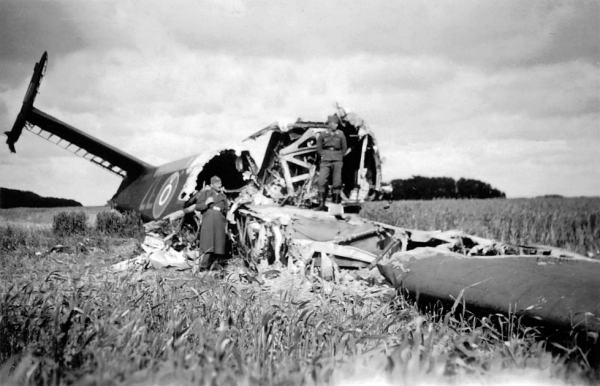Remembering the Crashed flyers in the PH-polders (low lying grassland), Netherlands
Translation from the Netherlands Newspaper article.
On Monday evening, exactly 68 years to date, about 20 interested people came to remember those flyers, which died in the crash of their bomber on June 13, 1943, on Epiphany, in the Prince Hendrikpolder.
It involved aircraft DK 183 from 427 Squadron of the Royal Canadian Air Force, one of twelve Halifax from 427 Squadron. It was on the way to an attack of the German city Bochum in the Ruhr district, part of a 38 aircraft operation.
Just prior to reaching its destination they encountered motor problems; they dropped the bombs and returned homewards. Above Texel they fell prey to German night flyers who were assisted by searchlights that were installed at the Mok and in the old port of Alexanderhoeve. The airplane caught on fire and made an emergency landing on the fields of MJ Kikker and W Roeper. It also landed hard on the side of a ditch between the farms Zeewijk and Capni, behind the barn where Jan Cupido had his flower business for many years.
On board were 5 Canadians and one British citizen. The 7th person on board, the Canadian belly gunner Albert Dixon, had left the plane by parachute and landed in the sea. His body washed ashore on the German Island Borkum. Navigator G W R Dalton (25) and radio operator BL Tedford (23) died in the crash. They are buried in the cemetery in Den Burg. Pilot A. M. Fellner, bombadier W.A. Thurston, tail gunner G. S. Huston and the 23 year old English technician James Imms were injured and were taken prisoner by the German soldiers who arrived at the wreck at about 4 pm. For unknown reasons Imms was shot in his abdomen and he died in a hospital in Amsterdam. He was buried in Belgen (Noord Holland). Thurston and Huston were sent to a prisoner of war camp and survived the war. Huston returned to Texel in 1977 and visited the crash site and the graves of his fallen comrades.
Fellner, it was his 13th mission with the DK183, never completely recovered from his severe injuries. After a prisoner of war exchange in Sweden he was sent home on a hospital ship in October 1944. Most likely he is the only one still alive. He is 93 and lives in Ontario, said Rob van Ginkel who organized this remembrance ceremony together with his neighbor Daan Welboren, and had lately been in contact with Fellner's son.
A couple of years ago, an old Texelaar (person from Texel) Jan Alkema who has emigrated to Canada, visited the pilot on request of Jan Kikkert (from Farm Hoornenburg) to ask some questions regarding the crash. His answers, together with what is available in books and on websites, gave Van Ginkel enough information to make an information board, which he constructed himself. This was revealed on Monday evening by Welboren and Kikkert. They did this by removing a Canadian flag that was draped over it.

After a minute of silence, Kikkert, who lived in Hoorn at the time, talked about his memories of the days after the crash, when as a child he went looking at the wreck. It made a great impression on him. For a long time nothing would grow in the surroundings of the spot, due to the seepage of oil and gas. For years pieces of the wreckage were found. A couple of years ago Welboren found a Dynamo and he donated it to the Air force and War Museum.
The remembrance was organized by Van Ginkel and Welboren to bring attention to the crash site. Since 2003 there is a large rock with a plaque but it doesn't get a lot of visitors, it is hoped that this spot will now be better known. A sign on the Pontweg would help as well. I don't know if we should have a yearly commemoration or maybe in 2 years when it is 70 years since the plane crashed, according to Van Ginkel, who recently published a book about the Dutch Rememberance.
From Patty Howard, Lou's daughter: Recently a gentleman by the name of Rob van Ginkel made contact with my family. He lives some 500 yards from the site where the Halifax that my father piloted crashed. It so happens that he recently published a book about the commemoration of WW II in the Netherlands and that the local Texel newspaper featured a story about it. This initiated a discussion between a couple of neighbours, including himself, who then decided to commemorate the crash and the four crew members who died on the 13th of June 1943. I have attached some photos that he said were from the Texel Air and War Museum's collection, along with the article translated in English. The gentleman in the red jacket in one of the photos was 13 years old when he saw the scene of the crash the morning after.
See also
For those able to do their own translation. The original newspaper article.

Copyright © 2007, 427 Squadron Association
Copyright © 2007 Logistix. Designed by Free CSS Templates
::: Modified with Coffee Cup - Web Design Software:::


